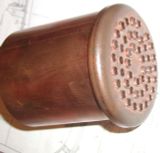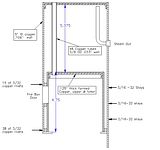sure could use some advise.
Hi Gary,
Let me say right at the start that you are to be congratulated for the substantial work you've done so far, this engine is not a simple project. And thanks for the boiler sketch, that has made answering your questions far easier.
Never could figure out the calculations for a safe boiler.
You shouldn't have to be bothered with this. Them's wot we pays our drawin' money for, to have that information worked out for us in advance by the designer. We could reverse-calculate the max safe WP (working pressure) for this boiler but I wouldn't bother. I can just look at the design details and say with a fair amount of confidence that it will be good for 100psi.
It has traditionally been accepted that the maximum practical working pressure for a properly designed copper boiler is about 125psi. Above this pressure steam temperatures are such that copper begins to lose some tensile strength, enough to begin to affect the design safety factor (ideally 8X), so most copper boilers are generally assumed to be operated at 100psi or less. Although it can be mathematically substantiated I ask you to accept my statement that this practice is "widely accepted" without supporting evidence. As above, I don't see anything about this boiler design that would prevent it being steamed at 100psi WP, if you wanted to, but knowing what I do about small engine behavior my thinking is it would be happiest running at somehere between 60 and 80 psi, but that's just a guess. Somewhere in your documentation it should state what the inteded operating pressure is.
Page 8 of instructions . . . Section 8 Boiler - It is believed about everyone has their own pet ideas about boilers. The one shown may not be to your fancy. O.K. Make changes as you wish.
Hmm . . well OK, but if I'm paying good money for drawings I don't want to have to guess what to do next. Also, it's easy for the inexperienced (or short-cut takers) to say "That oughta hold . ." There is another aspect of this is, liability, but I won't go there today.
I am a little shy from drawing thickness for some of the copper. Outer shell is listed at 1/8 wall and have .106 wall thickness. The 3/8 fire tubes shown in drawing say .035 wall and have about .031 wall.
I think all your tube thicknesses are adequate for the intended service. I always prefer as much wall thickness in flues as can be had and it appears what you have is Type L (.030" nominal wall thickness) but tube thickness varies a bit from mill to mill. If you were to use coal firing, a Type K (.035" nom) flue would be better from a cleaning wear standpoint but there would be no appreciable gain in safety AND 3/8" Type K is very difficult to find in small quanities.
Question. On the stays between outer boiler shell and fire box. Are these all done after the fire box and boiler tube are riveted together? Is the procedure tap drill both, clearance drill boiler outer, tap inside? Screw stay in and put nut on stay? Silver braze both joints?
This needs a lot of explaining and I'm running out of time this morning but in a nutshell, I would eliminate all but maybe one ring of of waterleg stays. Although there are crush limits, generally speaking tubular sections such as you have here are self-staying and need no stays however I would put in one row (or ring) about 2/3 way up in the water leg to maintain internal alignment of the inner and outer tubes. Also, ALL the joint strength in a silver-soldered boiler is derived from the silver solder so riveting the thing to death really doesn't gain you anything. You can use only enough fasteners to hold the thing together for soldering and not lose any strength. More on this later.
Question. There is a big bunch of things needing silver brazed besides the seams . . . there are 14 bushings for gauges and plumbing plus some brackets and studs. Having done some silver brazing, I'm a little intimidated at doing all this at one go. Would rolling the 46 fire tubes in using the squeezing rubber trick be OK?
I would do this boiler in two stages, possibly three. I would first assemble the inner firebox tube, the firehole ring, firebox head, and flues and solder that all up. Rolling the tubes wouldn't be needed. I would deform them a bit so that they push/pressed into their holes and stayed there on their own and then temporarily slip on the top head to hold them in alignment while the firebox assembly is soldered up. I would then slip this assembly into the assembled outer shell and finish up with a second heat. It will be VERY important that you have a large heat source for this job. More on soldering in assemblies when I have time.
Sorry I had to cut this short for today.







